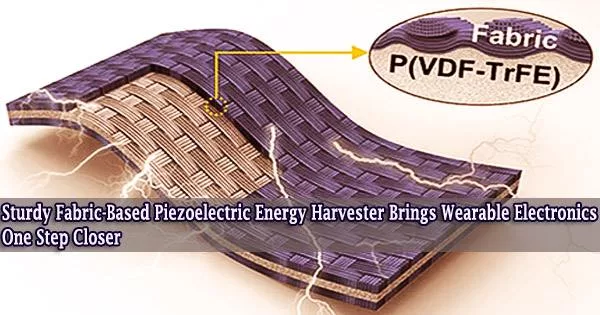Researchers from KAIST demonstrated a wearable piezoelectric harvester that is highly flexible but durable thanks to a straightforward production method called hot pressing and tape casting. This energy harvester will bring the development of embedded wearable electronics one step closer thanks to its record-high interfacial adhesion strength.
The novelty of this finding, according to a study team under the direction of Professor Seungbum Hong, resides in its ease of use, applicability, longevity, and novel classification of wearable electronic devices.
Wearable technology is being used more and more in a variety of applications, including those for embedded sensors, actuators, displays, and energy harvesters as well as miniature electronics. High costs and difficult fabrication procedures remained obstacles to commercialization despite their many benefits.
Their longevity was frequently questioned as well. Professor Hong’s team created a new manufacturing procedure and analytical technique to verify the mechanical qualities of reasonably priced wearable gadgets in order to address these problems.
The polyester fabric structures and a polymer film were joined for this method using a hot pressing and tape casting procedure. Due to its great adhesiveness, hot pressing has typically been utilized to manufacture batteries and fuel cells. Most importantly, the procedure only takes two to three minutes.
Similar to how graphic patches may be added to clothing using a heat press, the newly created fabrication procedure will allow direct placement of a gadget into common apparel.
This study could enable the commercialization of highly durable wearable devices based on the analysis of their interfacial adhesion strength. Our study lays a new foundation for the manufacturing process and analysis of other devices using fabrics and polymers. We look forward to fabric-based wearable electronics hitting the market very soon.
Professor Seungbum Hong
In specifically, the polymer film changes into an amorphous state when it is hot pressed onto a cloth below its crystallization temperature. It then compactly adheres to the fabric’s concave surface and penetrates the spaces between the longitudinal warps and transverse wefts.
High interfacial adhesion strength is the result of these characteristics. Because of this, hot pressing has the potential to lower the cost of manufacturing by directly attaching fabric-based wearable gadgets to everyday clothing.
The newly developed surface and interfacial cutting analysis system, in addition to the traditional durability test of bending cycles, demonstrated the high mechanical durability of the fabric-based wearable device by determining the high interfacial adhesion strength between the fabric and the polymer film.
According to Professor Hong, the study provides a fresh framework for the design, development, and production of textile and polymer-based wearable technology.
He stated that his team was the first to test the mechanical characteristics of wearable gadgets made of polymer using the surface and interfacial cutting analysis system (SAICAS) in the field of wearable electronics.
Because it analyzes adhesion strength qualitatively and quantitatively, its surface and interfacial cutting analysis technique is more accurate than traditional methods (peel test, tape test, and microstretch test).
Professor Hong explained, “This study could enable the commercialization of highly durable wearable devices based on the analysis of their interfacial adhesion strength. Our study lays a new foundation for the manufacturing process and analysis of other devices using fabrics and polymers. We look forward to fabric-based wearable electronics hitting the market very soon.”
The results of this study were registered as a domestic patent in Korea last year, and published in Nano Energy this month.
This study has been conducted through collaboration with Professor Yong Min Lee in the Department of Energy Science and Engineering at DGIST, Professor Kwangsoo No in the Department of Materials Science and Engineering at KAIST, and Professor Seunghwa Ryu in the Department of Mechanical Engineering at KAIST.















